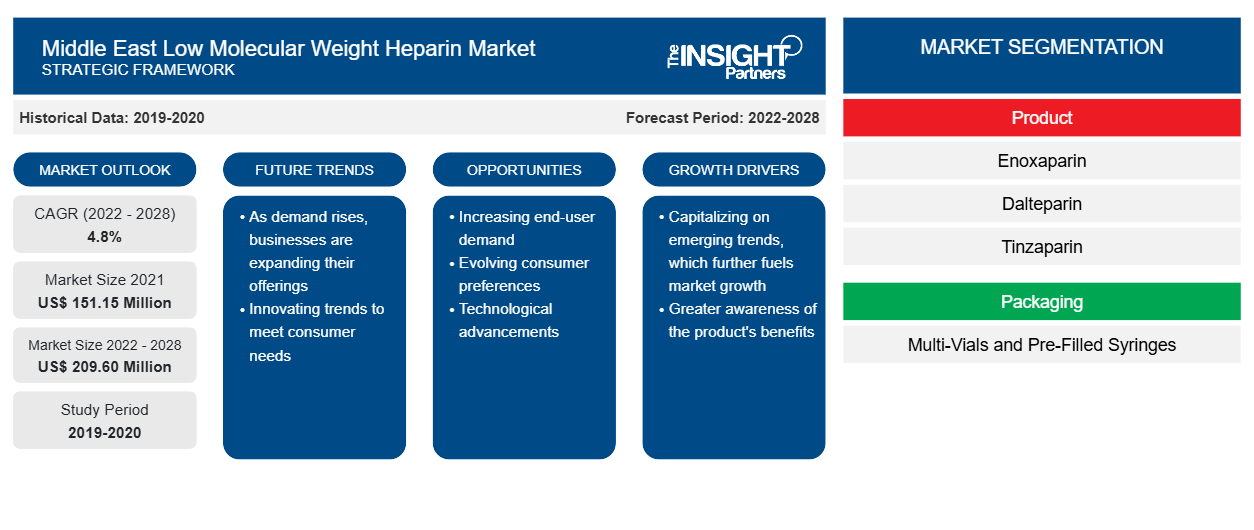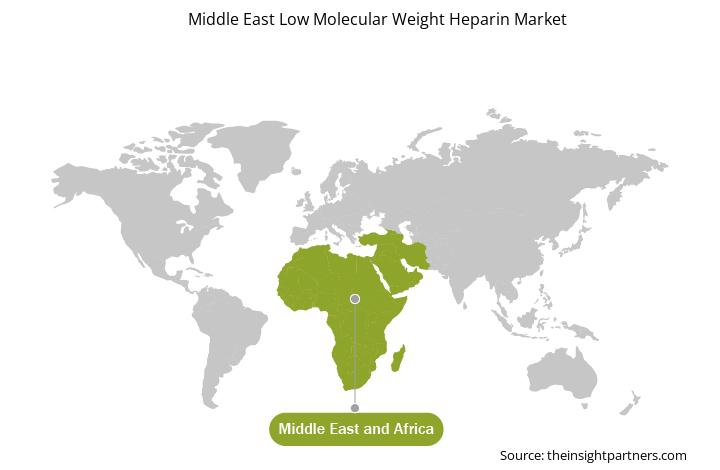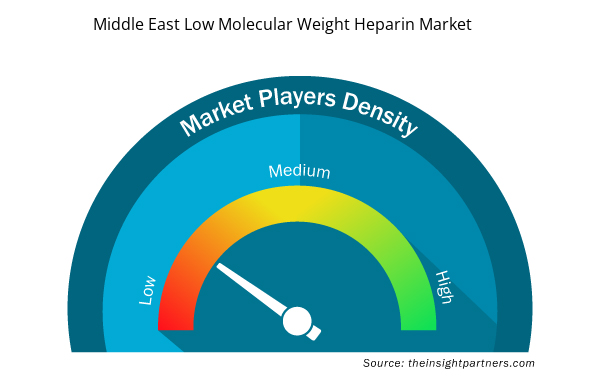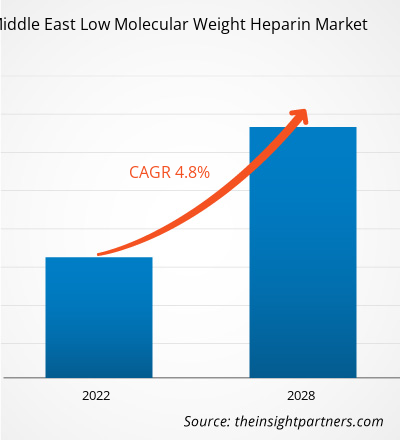The Middle East low molecular weight heparin market is expected to grow from US$ 151.15 million in 2021 to US$ 209.60 million by 2028. It is estimated to grow at a CAGR of 4.8% from 2022 to 2028.
Low molecular weight heparin (LMWH) is a class of anticoagulants. They are used to prevent blood clots and treat venous thromboembolism (deep vein thrombosis and pulmonary embolism) and treat myocardial infarction. LMWHs are defined as heparin salts with an average molecular weight of less than 8,000 Daltons and in which at least 60% of all chains have a molecular weight of less than 8,000 Da. These are obtained by various methods of fractionation or depolymerization of polymeric heparin. Low molecular weight heparin offers advantages over heparin such that it has better bioavailability and longer half-life, simplified dosing, predictable anticoagulant response, and lower risk of osteoporosis.
The report offers insights and in-depth analysis of the Middle East low molecular weight heparin market, emphasizing various parameters, including market trends, technological advancements, market dynamics, and competitive landscape analysis of the Middle East leading market players. It also includes the impact of the COVID-19 pandemic on the market across all regions. The overall COVID-19 impact on the Middle East low molecular weight heparin market is positive; hence, the market is gaining traction and is expected to grow in the coming years. In the past several decades, countries in the Middle East have strengthened their health systems and upgraded public and commercial healthcare. However, the limited availability of resources (including trained staff and medical equipment) and the burden of noncommunicable diseases harm the overall healthcare system in the region. In 2020, the COVID-19 pandemic significantly impacted the delivery and accessibility of social services, education, health and nutrition, healthcare spending, and well-being. Due to the region's dependence on trade and tourism and struggles with substantial youth unemployment, the global crisis led to serious long-term effects on the region. Governments in the Middle East allocated funds to prevent the overburdening of their health systems and decelerate the spread of COVID-19 in 2020; a few countries also emphasized on increasing the number of intensive care units and hospital beds.
According to the National Institute of Health (NIH) report (2020), low molecular weight heparin utilization was high during the COVID-19 pandemic. In COVID-19-induced acute respiratory distress syndrome, the lungs could not fill with sufficient air, causing hypoxemia and high mortality among hospitalized patients. Therefore, patients with evidently worst clinical presentation were prescribed low molecular weight heparin via a soft mist inhaler dosing 4000 IU per administration twice daily.
Geography-Based Insights
By geography, the Middle East low molecular weight heparin market is segmented into Saudi Arabia, the UAE, Kuwait, Qatar, Lebanon, Bahrain, Oman, Yemen, Iraq, Israel, Jordan, and the Rest of Middle East.
Market Insights
High Prevalence of Cardiovascular Diseases in Middle East Countries
Countries in the Middle East are witnessing a high prevalence of cardiovascular disorders (CVDs) such as venous thromboembolism (VTE), pulmonary embolism (PE), deep vein thrombosis (DVT), coronary heart disease (CHD), and stroke. Owing to the rising demand for treatment associated with these diseases, the low molecular weight heparin market is growing in the UAE, Saudi Arabia, Kuwait, Oman, Qatar, and other Middle East countries. CVD has emerged as a leading cause of morbidity and mortality in the UAE. The Public Library of Science (PLOS) 2020 states that CVD contributes to 40% of all incidence and deaths among young and adults, owing to the increasing burden of abdominal obesity (71.5%), dyslipidemia (74%), hypertension (43%), and diabetes (32.4%) in the UAE. Further, the Al-Azhar Assiut Medical Journal report states that in 2020, the population of Saudi Arabia has a high prevalence of hypertension (~49% population), while 5–6% of the population is diagnosed with CHD. Additionally, the Discovery Publication report 2020 states that PE is a prevalent and major cause of illness in Saudi Arabia. Thus, the high prevalence of CVDs in countries in the Middle East is driving the market.
Furthermore, according to the National Institute of Health (NIH) report, CVD is a major cause of death in Kuwait, as it is responsible for ~46% of mortalities yearly. Additionally, according to the Ministry of Public Health (MoPH) report, CVD is the primary cause of death in Qatar and is considered an economic burden. According to the World Health Organization (WHO), CVD accounts for ~47% and ~27% of all deaths each year in Lebanon and Iraq, respectively. Also, According to World Bank data (2019), CVD is the leading cause of noncommunicable diseases (NCDs) in Bahrain, accounting for ~16% of the deaths in the country. Also, the NIH reported that CHD accounts for ~10.5% of all deaths of people aged 45–60 and 31.5% for those above 65 years in Oman. Thus, the high prevalence of CVDs in the region is driving the Middle East low molecular weight heparin market.
Product-Based Insights
Based on product, the Middle East low molecular weight heparin market is segmented into enoxaparin, dalteparin, tinzaparin, fraxiparine, nadroparin, and others. The enoxaparin segment held the largest market share in 2021. The dalteparin segment is anticipated to register the highest CAGR in the market during the forecast period.
The Middle East Low Molecular Weight Heparin Market, by Product – 2021 and 2028

- This FREE sample will include data analysis, ranging from market trends to estimates and forecasts.
In terms of packaging, the market is bifurcated into multi-vials and pre-filled syringes. The multi-vials segment held a larger share in 2021. The prefilled syringes segment is anticipated to register a higher CAGR during the forecast period.
Based on application, the Middle East low molecular weight heparin market is segmented into deep vein thrombosis, acute coronary syndrome, pulmonary embolism, and others. The deep vein thrombosis segment led the market in 2021. However, the acute coronary syndrome segment is expected to grow at the highest CAGR during the forecast period.
In terms of end user, the market is segmented into hospitals, clinics, ambulatory surgical centers, and others. The hospitals segment accounted for a maximum share in 2021. However, the clinics segment is expected to grow at the highest CAGR during the forecast period.
Based on distribution channel, the market is segmented into hospital pharmacies, retail pharmacies, and others. The hospital pharmacies segment held the maximum share in 2021, and the retail pharmacies segment is expected to grow at the highest CAGR during the forecast period.
Customize This Report To Suit Your Requirement
You will get customization on any report - free of charge - including parts of this report, or country-level analysis, Excel Data pack, as well as avail great offers and discounts for start-ups & universities
Middle East Low Molecular Weight Heparin Market: Strategic Insights

- Get Top Key Market Trends of this report.This FREE sample will include data analysis, ranging from market trends to estimates and forecasts.
Report ScopeYou will get customization on any report - free of charge - including parts of this report, or country-level analysis, Excel Data pack, as well as avail great offers and discounts for start-ups & universities
Middle East Low Molecular Weight Heparin Market: Strategic Insights

- Get Top Key Market Trends of this report.This FREE sample will include data analysis, ranging from market trends to estimates and forecasts.
Middle East Low Molecular Weight Heparin Market Regional Insights
The regional trends and factors influencing the Middle East Low Molecular Weight Heparin Market throughout the forecast period have been thoroughly explained by the analysts at Insight Partners. This section also discusses Middle East Low Molecular Weight Heparin Market segments and geography across North America, Europe, Asia Pacific, Middle East and Africa, and South and Central America.

- Get the Regional Specific Data for Middle East Low Molecular Weight Heparin Market
Middle East Low Molecular Weight Heparin Market Report Scope
| Report Attribute | Details |
|---|---|
| Market size in 2021 | US$ 151.15 Million |
| Market Size by 2028 | US$ 209.60 Million |
| Global CAGR (2022 - 2028) | 4.8% |
| Historical Data | 2019-2020 |
| Forecast period | 2022-2028 |
| Segments Covered |
By Product
|
| Regions and Countries Covered | Middle East and Africa
|
| Market leaders and key company profiles |
Middle East Low Molecular Weight Heparin Market Players Density: Understanding Its Impact on Business Dynamics
The Middle East Low Molecular Weight Heparin Market is growing rapidly, driven by increasing end-user demand due to factors such as evolving consumer preferences, technological advancements, and greater awareness of the product's benefits. As demand rises, businesses are expanding their offerings, innovating to meet consumer needs, and capitalizing on emerging trends, which further fuels market growth.
Market players density refers to the distribution of firms or companies operating within a particular market or industry. It indicates how many competitors (market players) are present in a given market space relative to its size or total market value.
Major Companies operating in the Middle East Low Molecular Weight Heparin Market are:
- Teva Pharmaceutical Industries Ltd
- Abbott Laboratories
- Novartis AG
- Sanofi
- Pfizer Inc.
Disclaimer: The companies listed above are not ranked in any particular order.

- Get the Middle East Low Molecular Weight Heparin Market top key players overview
- Historical Analysis (2 Years), Base Year, Forecast (7 Years) with CAGR
- PEST and SWOT Analysis
- Market Size Value / Volume - Global, Regional, Country
- Industry and Competitive Landscape
- Excel Dataset



Report Coverage
Revenue forecast, Company Analysis, Industry landscape, Growth factors, and Trends

Segment Covered
This text is related
to segments covered.

Regional Scope
North America, Europe, Asia Pacific, Middle East & Africa, South & Central America

Country Scope
This text is related
to country scope.
Trends and growth analysis reports related to Life Sciences : READ MORE..
The List of Companies - Middle East Low Molecular Weight Heparin Market
- Teva Pharmaceutical Industries Ltd
- Abbott Laboratories
- Novartis AG
- Sanofi
- Pfizer Inc.
- B. Braun SE
- Dr. Reddy's Laboratories
- LEO Pharma A/S
- Aspen Holdings
- Hikma Pharmaceuticals PLC.

 Get Free Sample For
Get Free Sample For